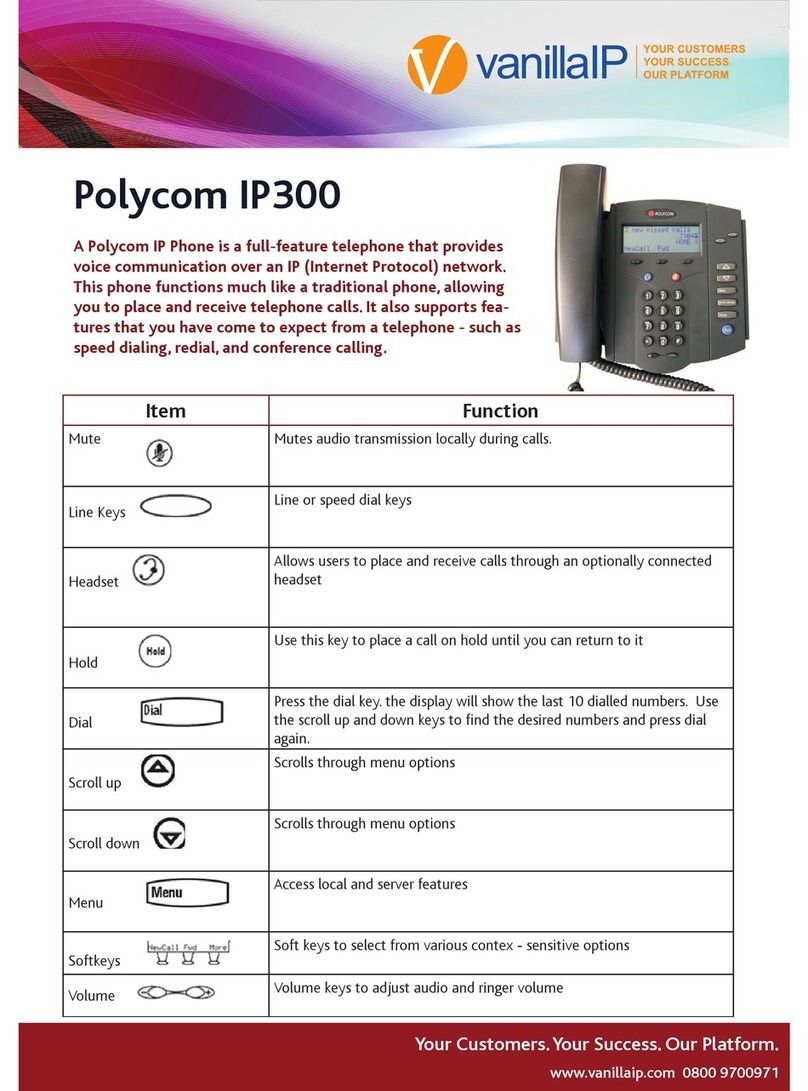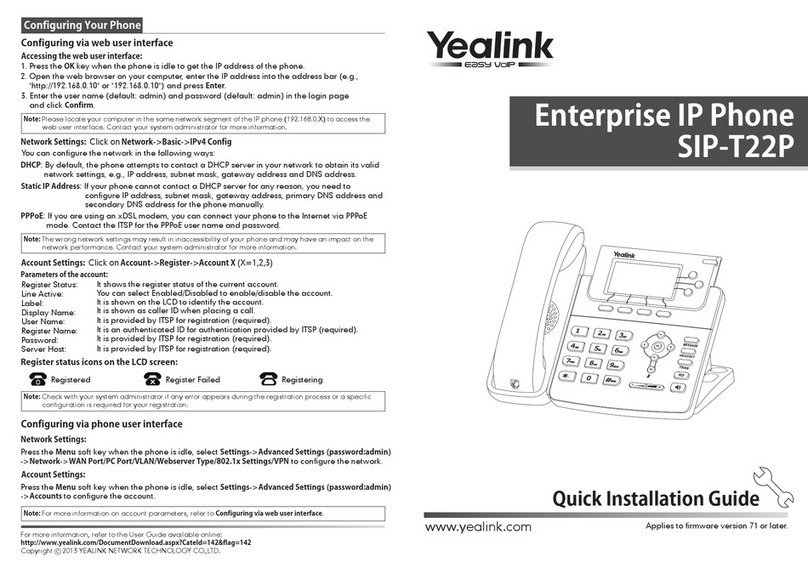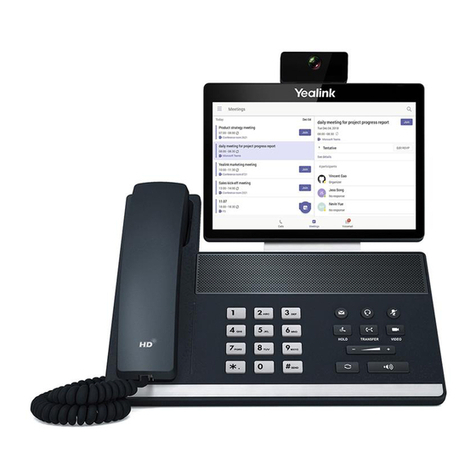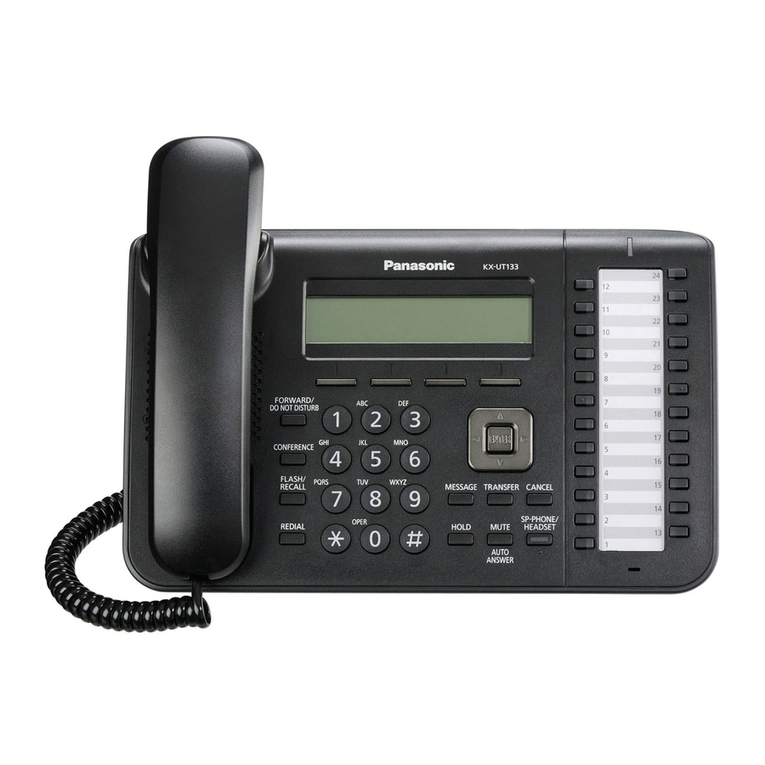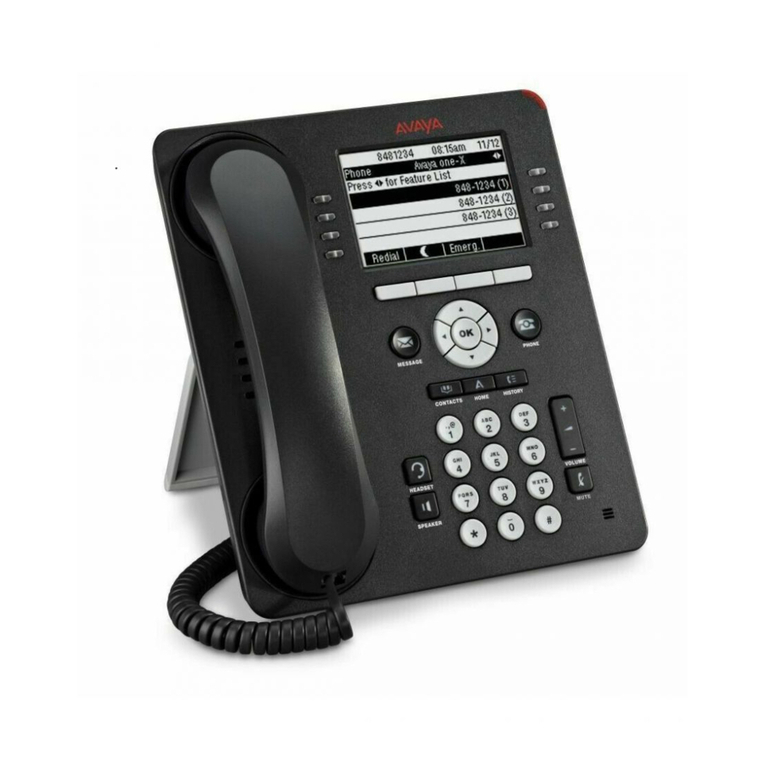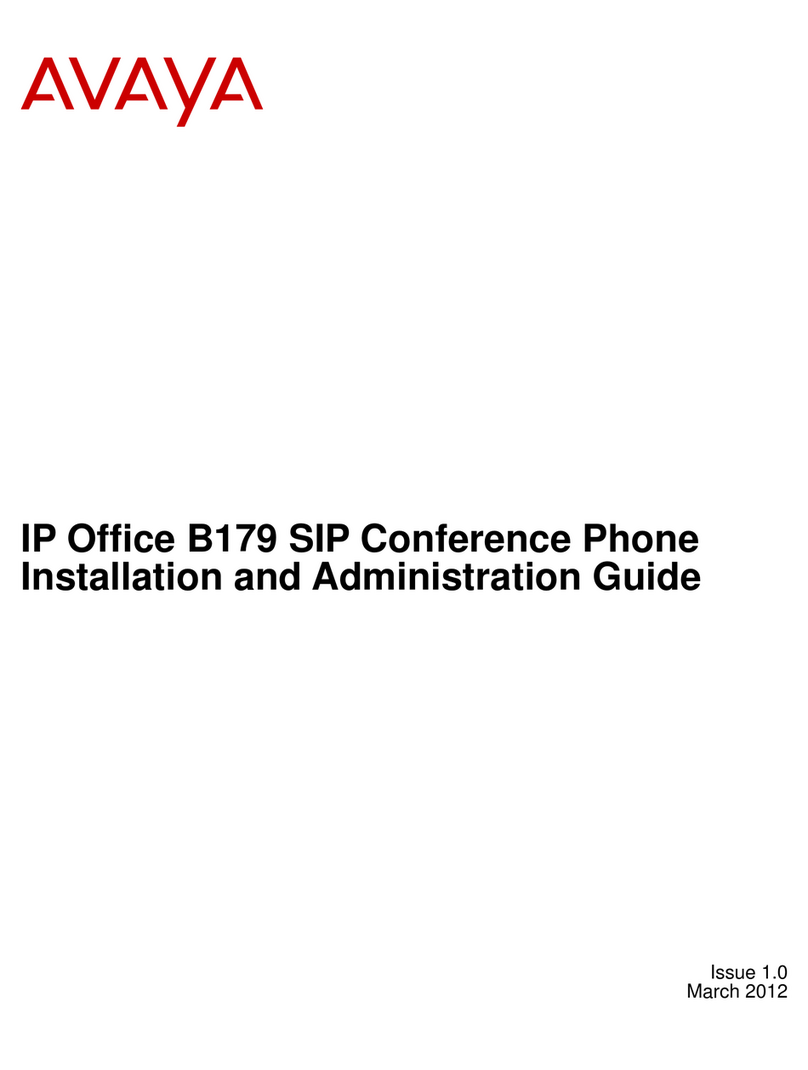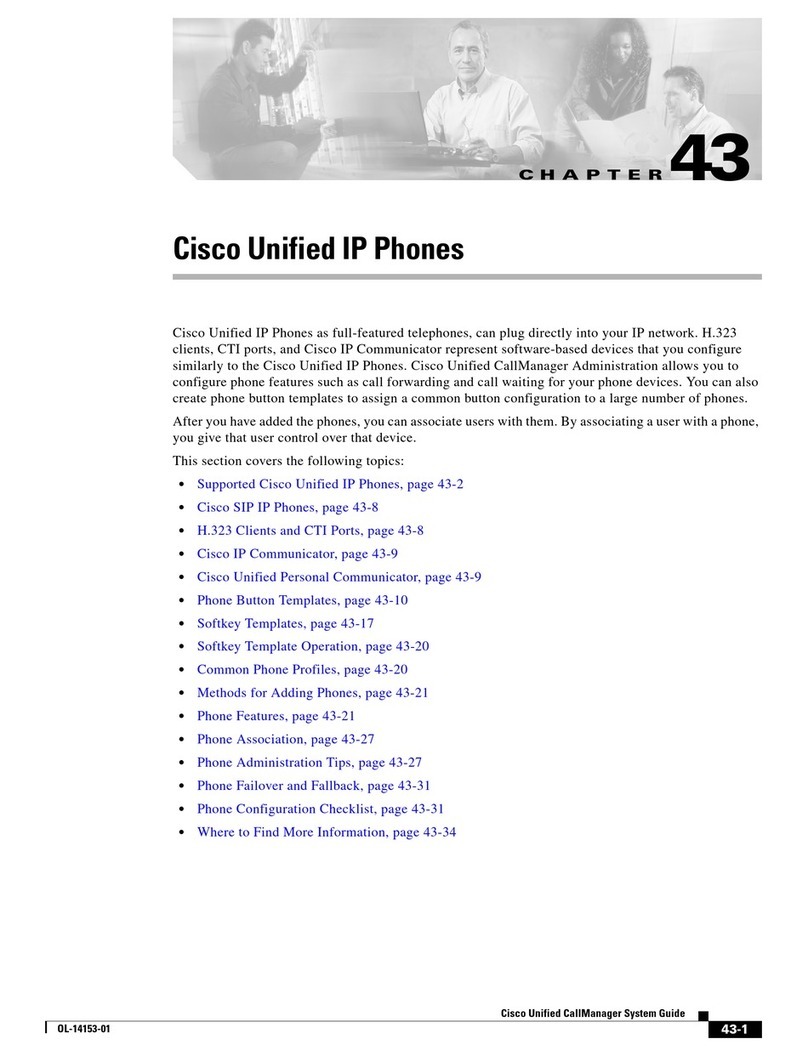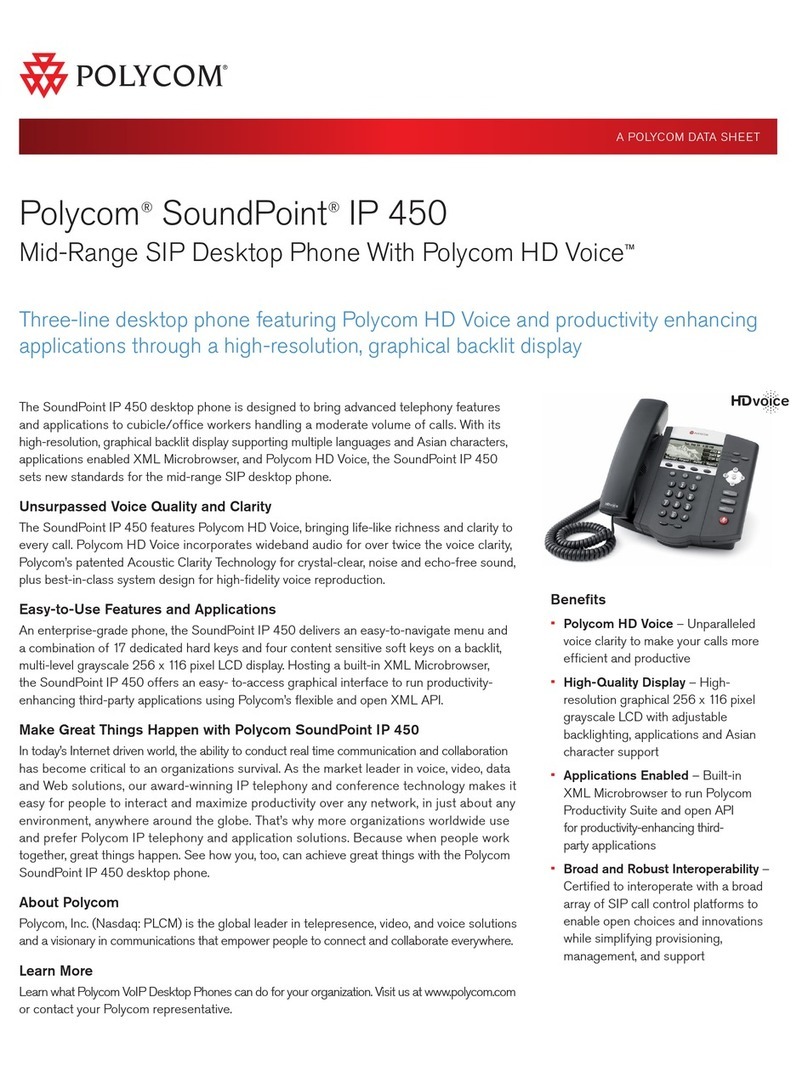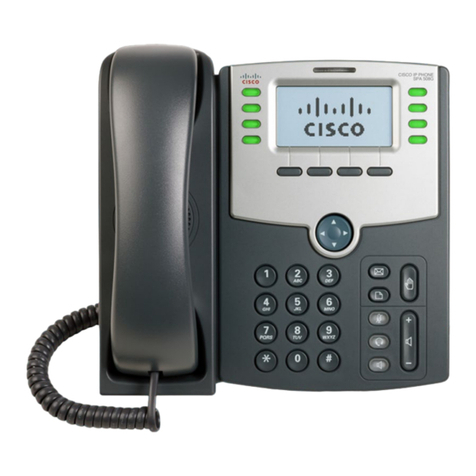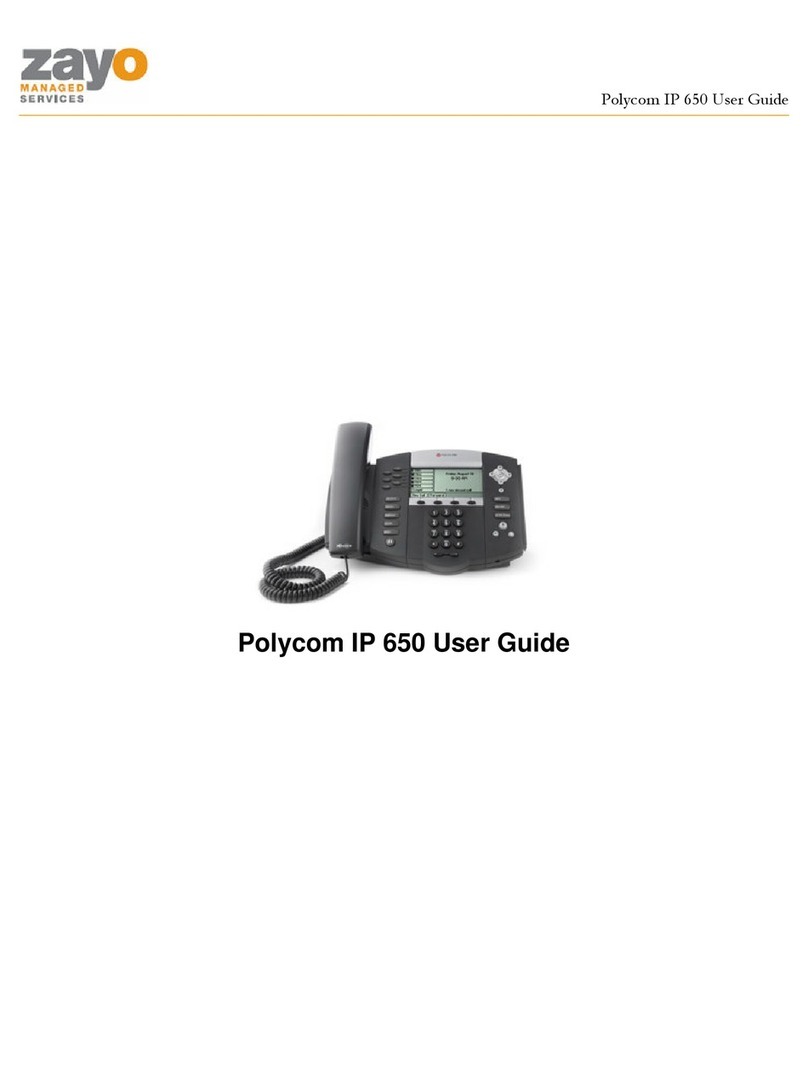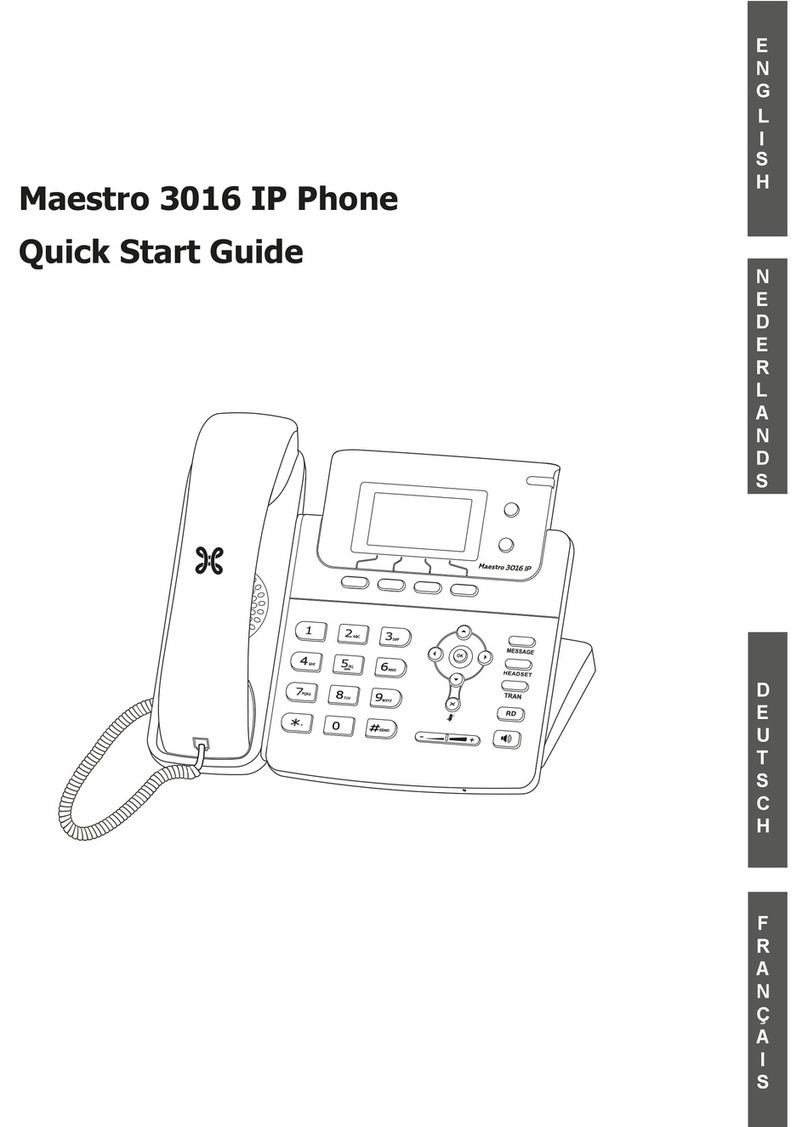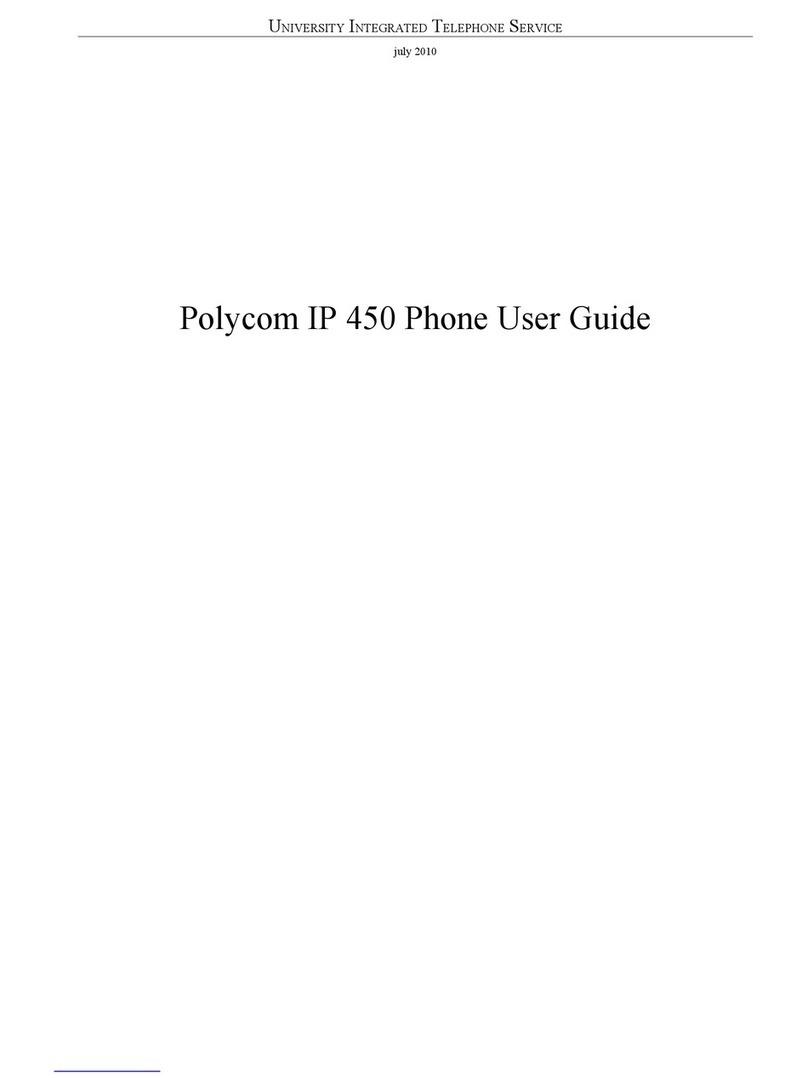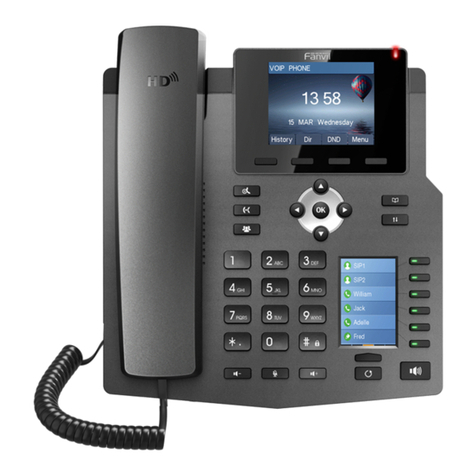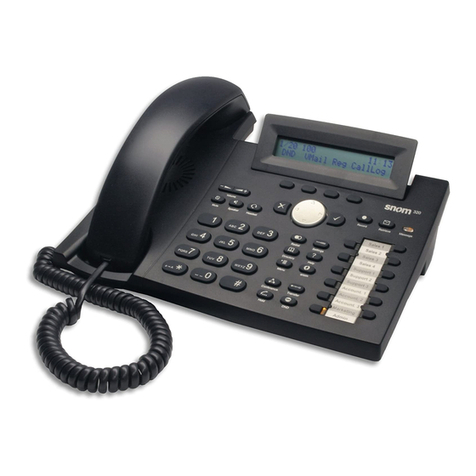Swissvoice IP 20 User manual

IP 15 - IP 20
User guide Corded IP phones

About Swissvoice IP phones
202C110500C - web
This user manual is dedicated for both Swissvoice IP15 and IP20 IP phones. Swissvoice IP phones
bring a broad array of telephony services and advanced IP features. The following table points out
the differences between the IP20 and the IP15. Other features described in this manual are
common to both models.
Feature IP15 IP20
Hands-free ●● Full duplex
Locally managed conferencing ●
PC switch Option* ●
G711 codec ●●
G722 codec ●
G723 codec Option* ●
G729 codec Option* ●
* These options must be chosen at purchase time and cannot be changed
afterwards. IP 15 can have a second codec: either G723 or G729.

02C110500C - web 3
Contents
About Swissvoice IP phones ............................................................... 2
Operation and display elements ......................................................... 4
Safety advice ............................................................................................ 6
The menu system ................................................................................... 7
Telephoning .............................................................................................. 9
Incoming calls .......................................................................................... 13
During a conversation ........................................................................... 14
Using the extended-feature functions ............................................... 16
Telephone configuration ........................................................................ 21
Factory settings ....................................................................................... 22
Setting the display language ............................................................... 23
User settings ............................................................................................ 24
Admin settings ......................................................................................... 28
Phonebook and memory keys ............................................................ 35
Configuration through a web browser .............................................. 37
Installation ................................................................................................. 39
Troubleshooting ....................................................................................... 41
Further information ................................................................................. 42

402C110500C - web
OK
ABC
i
MENU
END
12
ABC
DEL
3
DEF
4
GHI
5
JKL
6
MNO
7
PQRS
8
TUV
9
WXYZ
0
1 2
5
6
7
3 4 15
13
11
12
8
910
14
1 Display
■Top: information
■Bottom: functions, symbols
2 Function key
■
Activates allocated
function
■Adjusts volume
■Scrolls in a list
3 Alpha key
■Name search
4 Info key
■Calls up further information
i
ABC
OK +
-
OK +
-
OK +
-
5 Attention LED
■Flashing: incoming call
■Lit: notification available
(e.g. new voice mail)
6 Menu key
Menu access key
■Short: scrolls through menu
■Long: configuration mode (settings)
7 Keyboard
■Short: enters digits or letters
■Long: memory key
8 Loudspeaker key
■Loudspeaker on/off
■Hands-free line taking
MENU
Operation and display elements

02C110500C - web 5
9 Redial key
■Call numbers last dialled
10 End key
■In a call:
terminates connection and opens a new
line
■In configuration and navigation mode:
- short click: back to upper menu,
- long click: back to idle text.
END
11
Loudspeaker
12 Correction key
■Deletes the last character
13 Label
14 Hook switch
15 Hands-free microphone
DEL
OK
ABC
i
MENU
END
12
ABC
DEL
3
DEF
4
GHI
5
JKL
6
MNO
7
PQRS
8
TUV
9
WXYZ
0
1 2
5
6
7
3 4 15
13
11
12
8
910
14
Operation and display elements

602C110500C - web
Safety advice
Information to the user
Federal Communications Commission
This equipment has been tested and found to comply with the limits for a Class A digital device,
pursuant to part 15 of the FCC Rules. These limits are designed to provide reasonable protection
against harmful interference when the equipment is operated in a commercial environment. This
equipment generates, uses, and can radiate radio frequency energy and, if not installed and used
in accordance with the instruction manual, may cause harmful interference to radio
communications. Operation of this equipment in a residential area is likely to cause harmful
interference in which case the user will be required to correct the interference at his own expense.
General
This telephone is to be operated on an Ethernet LAN. The calls are handled by an MGCP (Media
Gateway Control Protocol) Call Manager.
Please follow the instructions in this document and keep it handy and in a safe place.
Connection
Plug the telephone's connecting cables into the appropriate sockets only. Never try to change the
plugs on the connecting cables.
Location
Place your telephone on a non-slip surface.
Choose a location with an ambient temperature between +5 ˚C and +35 ˚C.
Do not expose the telephone to direct sunlight or other sources of heat.
Avoid wet or dusty locations.
Avoid locations where your telephone is exposed to aggressive liquids or vapours/steam.
Avoid locations in the immediate vicinity of hi-fi and video equipment, domestic appliances,
monitors, and electric motors (influence of electromagnetic fields). If your Swissvoice IP telephone
is connected to a PC, the monitor may cause electromagnetic interferences.
Avoid placing in areas with an explosion hazard.
Security
The plug-in power supply is used as disconnection device.
The network and power supply accesses of the phone are classified SELV (Safety Extra Low Voltage).
The mains access of the plug-in power supply is classified Dangerous Voltage.
Operation
Never carry the telephone by its connecting cord.
Never telephone in the immediate vicinity of water.
Clean the set with a soft, slightly damp or anti-static cloth. Do not use any detergents or chemicals
to clean the set.
Defects
If your telephone is faulty or defective, please contact your supplier.
Never dismantle the telephone yourself. Changes or modifications not expressly approved by
Swissvoice could void the user's authority to operate the equipment.

02C110500C - web 7
Introduction
The smart high-tech menu system makes your telephone very
simple to operate. The MENU key allows you to find the different
menus and menu items with ease. Use it as follows:
If you wish to activate one of the functions on the lower display
line (for example, "Call" after selecting a number), press OK
below the corresponding word.
If you cannot find the function you want, press the MENU key
repeatedly until you find it.
Example:
Press MENU key once.
Press MENU key a second time.
To go back to the upper menu, press the END key.
To go back to the idle text, press the END key during two seconds.
Note: Pressing the MENU key long (for at least 2 seconds) puts
the system in its configuration mode "User settings".
Special display symbols
Handsfree.
Loudspeaker on.
Headset mode.
More information available.
Microphone off (mute).
The menu system
OK +
-
MENU
MENU
MENU
END
END

802C110500C - web
The menu system
The menu tree
Password
Reset
Phonebook
Pickup
Search
Scroll
New
Memory keys Change
Delete
New
Functions*
DoNotDisturb
Call forward Permanent
Rings
On busy
No reply
All
Common
Private
All
Common
Private
User settings
Ring
Display
Admin settings TCP/IP
Voice mail*
Time zone
Date
Time
Idle text
Contrast User name
External number
Internal number
Free text
Internal
External Melody
Rate
Volume
*Language
Headset
English
Deutsch
Français
Español
Call waiting
Italiano
QoS
Call agent
Tone table
Password
MENU
* Functions availability is dependent on the the call agent.
Note: press i to check system parameters

02C110500C - web 9
Swissvoice IP15 and Swissvoice IP20 allow you to directly dial in DTMF mode (tone dialling),
giving you all the comfort of advanced services where the use of the * and # keys is necessary.
This chapter describes the available dialling methods:
■Dialling with dialling preparation (on-hook),
■Dialling by digits (off-hook),
■Dialling by name,
■Dialling using memory keys,
■Dialling using the Redial key,
■Dialling using the Call list,
■Dialling with the headset.
Dialling with dialling preparation (on-hook)
Without lifting the receiver, enter the desired number.
Check the number on the display and, if necessary, correct using
the Correction key.
Then, press OK under "Call",
or
press the Loudspeaker key,
or
lift the receiver.
To abort a dialling preparation, press the END key.
Dialling by digits (off-hook)
Enter digits.
Telephoning
OK +
-
DEL
Call

Dialling by name
There are two options:
■Using the Dialling key
Press the ABC key.
Enter the first letters of the name.
Enter more letters until the telephone finds one or more names in
the "Phonebook".
Example: To call Sarah Jones
"Jones": Press key once, key three times, key twice
and so on.
By pressing #, you can enter a space. Numbers or names
entered during dialling preparation can be corrected using the
Correction key (deletes the last number/letter).
Hint: If two or more names in the "Phonebook" correspond to the
name just entered, the first one will be displayed. You can scroll
to the other names found.
Scroll displayed information with the navigation keys, to select
the desired name.
Press OK under "Call" to confirm the number,
or
lift the receiver,
or
press the Loudspeaker key.
■Using the "Phonebook"
Press the MENU key twice.
Press OK under "Phonebook".
Press the MENU key
Press OK under "Search".
Enter the first letters of the name.
Enter more letters until the telephone finds one or more names in
the "Phonebook".
6
MNO
6
MNO
5
JKL
10 02C110500C - web
Telephoning
ABC
MENU
MENU
OK +
-
OK +
-
Call
OK +
-
Phonebook
OK +
-
Search

02C110500C - web 11
Scroll displayed information with the navigation keys to select the
desired name.
Press OK under "Call" to confirm the number,
or
lift the receiver,
or
press the Loudspeaker key.
Dialling using memory keys
Press the desired number key during 2 seconds.
Press OK under "Call" to confirm the number,
or
lift the receiver,
or
press the Loudspeaker key.
Dialling using the redial key
To redial one of the last 30 dialled numbers:
Press the Last number redial key repeatedly until the desired
number is displayed.
Press OK under "Call" to confirm the number,
or
lift the receiver,
or
press the Loudspeaker key.
Telephoning
OK +
-
OK +
-
Call
OK +
-
Call
2
ABC
OK +
-
Call

Dialling using the call list
Your telephone automatically stores the names and numbers of
the last 30 answered and the last 30 unanswered calls in the call
list. An "i" in the lower right hand corner indicates new calls. You
can check these names and numbers and use this list to call
back the corresponding contacts.
For every call, the number, the name (if included in the
"Phonebook"), the date and time of the call are available.
To make a call from the list or to delete call data:
Press the i key.
Press OK under "Call list".
Scroll with the MENU key to choose between "Unans.calls"
(Unanswered calls) and "Anws.calls" (Answered calls).
Press OK under the selected item.
Scroll with the Function key to select the desired caller.
Press i to check additional information (date and time of the call).
Press OK under "Call" to confirm a call,
or
Press the MENU key repeatedly to either save or delete the
current number.
Dialling with the headset
A headset can be used instead of the handset. The headset
function has to be activated in the menu "User parameters"
(see p.24).
■To activate a call:
Dial the number.
Press the Loudspeaker key.
■To end a call:
Press the Loudspeaker key.
■To answer a call:
Press the loudspeaker key.
12 02C110500C - web
Telephoning
OK +
-
Call list
OK +
-
OK +
-
Key
OK +
-
Call
i
MENU
i

02C110500C - web 13
Display of caller’s name
When someone calls you, the number or the name is received
and displayed (CLIP).
The name appears in the display if this number is stored with the
name in the "Phonebook" or in the memory keys.
Note: This is software and call agent dependent.
Adjusting the ring volume
While the phone is ringing you can adjust the ringing volume of
your telephone by pressing + or - on the Function key (7 levels).
The new ringing volume is saved for the following calls.
Answering a call
To answer incoming calls, lift the receiver,
or
press the Loudspeaker key for hands-free mode,
or
Press OK under "Answer" for hands-free mode.
Call waiting
During a call, you receive a second call. This call is signalled by
a call waiting tone and the caller’s number is displayed.
Press OK to accept this call. The first one is automatically put on
hold.
Incoming calls
OK +
-
OK +
-
Accept
OK +
-
Answer

Swissvoice IP15 and Swissvoice IP20 allow you to directly dial in DTMF mode (tone dialling),
giving you all the comfort of advanced services where the use of the * and # keys is necessary.
Listening options
There are two possibilities:
Listen through the receiver (personal listening),
or
listen through the built-in loudspeaker on the terminal (Group
listening).
Group listening is shared listening. It is useful when other people
in the room need to listen and participate during your call. You
can let the persons in the room within hearing distance listen in
by pressing the Loudspeaker key.
Note: The Loudspeaker key alternately toggles the loudspeaker
on or off.
Hands-free operation
This feature allows you to answer calls through the loudspeaker,
without picking up the receiver. To activate this feature:
Leave the receiver on-hook.
Press the loudspeaker key.
To end the call, press the Loudspeaker key, or to continue the
call with the handset, just pick it up.
Note: Speech quality decreases with distance from the terminal.
Hint: To go from personal listening to hands-free mode, press
the Loudspeaker key (group listening) and hang up.
Volume adjustment
The volume in the receiver and the loudspeaker can be changed
during a conversation.
To adjust the volume during a conversation, press + (up) or -
(down) on the Function key.
14 02C110500C - web
During a conversation
OK +
-

02C110500C - web 15
Microphone off
If you wish to talk to someone in the room without the calling
party hearing, press the Mute key.
To switch the microphone on again press the Mute key.
During a conversation

Beyond basic telephony functions, Swissvoice IP telephones support the following call-handling
options. The use of these functions is dependent on their availability on the call agent. The way the
functions described thereafter work may vary from call agent to call agent. This list is not
exhaustive. Additional functions may be available on updated software releases. Furthermore, the
telephones may offer other services made available by the call agent. In this case, the telephones
display the information provided by the call agent.
■Pickup
■Enquiry call
■Brokering
■Call transfer
■Call hold
■Conference call
■Call forwarding
■Call waiting
■Do not disturb
■Voice mail
Pickup
A colleague’s phone is ringing. You want to intercept the call on
your own telephone.
Press the MENU key.
Press OK under "Pickup".
Enter the number of the telephone which incoming call you want
to intercept.
16 02C110500C - web
OK +
-
Pickup
Using the extended-feature functions
MENU

02C110500C - web 17
Using the extended-feature functions
Enquiry call
You (B) are conversing with one party (A) and wish to make a
brief call to another party (C) while holding the existing
connection (AB).
Press OK under "Enquiry call".
Enter the number for the enquiry party (C).
Hint: During an enquiry call, you can:
■switch back and forth between the parties (Brokering),
■cancel the enquiry call,
■transfer the call (AB to AC),
■set up a conference.
Brokering
After initiating an enquiry call (BC), you can return to the first
caller without ending the enquiry call connection. Afterwards, you
can switch back and forth between the first call and the enquiry
call as often as desired (brokering).
Proceed from the first call:
Press OK under "2nd conv."
(first call is on hold).
Press OK under "2nd conv."
(second call is on hold).
Press OK under "2nd conv."
(first call is on hold).
Cancel the enquiry call
If the enquiry call is not answered or you wish to disconnect the
enquiry party, press OK under "2nd conv." to go back to your first
conversation (AB).
Note: The enquiry party needs to hang up to disconnect.
OK +
-
2nd conv
OK +
-
2nd conv
OK +
-
2nd conv
OK +
-
2nd conv
OK +
-
Enquiry call

18 02C110500C - web
Using the extended-feature functions
Transferring the call
After initiating an enquiry call, you wish to connect the two call
partners.
Replace the receiver. The connection is done.
Conference
After initiating an enquiry call, you wish to set up a conference
including your original call partner.
Press the MENU key.
Press OK under "Conference".
Note: Be assured that none of your partners will be
disconnected while your are setting up a conference call. The
connections will only be disconnected if the "END" key is
pressed or if the receiver is replaced.
Holding a call
You can put a call on hold during a conversation.
Press the MENU key.
Press OK under "Hold" and the call is on Hold. This is confirmed
by the message "Executed".
To take a call back, press the OK under "Take back". You are
immediately connected to the first call again.
To initiate a second call while the first one is on hold, press the
MENU key and then OK under "Enquiry call".
OK +
-
Conference
MENU
OK +
-
Hold
OK +
-
Take back
OK +
-
Enquiry call
MENU
MENU

02C110500C - web 19
Using the extended-feature functions
Forwarding a call
Besides the terminal mobility option, you can divert all incoming
calls to another subscriber, to your Voice Mail or to the
switchboard operator.
Press the MENU key until "Functions" is displayed.
Press OK under "Functions".
Press OK under "CallForward".
Press the MENU key to select the type of diversion and confirm
with OK. You can choose between "CFW: Permanent", "CFW: on
busy", "CFW: no reply".
Enter the diversion destination and confirm with OK.
The message "Executed" briefly appears. Depending on the type
of diversion (respectively, Permanent, On busy, No reply),
the following display appears: "Div. to XYZ", "Div. busy to XYZ",
"CFW to XYZ", where XYZ is the number or the name of the
destination the call is forwarded to.
Call waiting
Press the MENU key until "Functions" is displayed.
Press OK under "Functions".
Press the MENU key until "CallWaiting" is displayed.
Press OK under "CallWaiting".
Select "On" or "Off" with the Function key and confirm with OK.
MENU
MENU
MENU
MENU
OK +
-
Functions
OK +
-
CallForward
OK +
-
Functions
OK +
-
CallWaiting
OK +
-
On/Off
OK +
-
OK +
-

Do not disturb
Press the MENU key until "Functions" is displayed.
Press OK under "Functions".
Press the MENU key until "DoNotDisturb" is displayed.
Press OK under "DoNotDisturb".
Select "On" or "Off" with the Function key and confirm with OK.
Voice mail
Your Swissvoice IP telephones give you notification messages
from any centralized voice mail system and allow you to consult
your messages easily. If you have new messages, an "i" will
appear on the bottom right of the screen and the LED will be
permanently lit.
To access to your new voice mails, click the i key until "Voice
mail" appears.
Press OK under "Voice mail".
Follow the vocal instructions.
Note: You can access the Voice mail menu (to modify your
absence message, for example) even if you do not have new
messages.
Press the MENU key until "Voice mail" is displayed.
Press OK under "Voice mail".
Follow the vocal instructions.
Using the extended-feature functions
20 02C110500C - web
MENU
MENU
OK +
-
Functions
i
MENU
OK +
-
Voice mail
OK +
-
Voice mail
OK +
-
DoNotDisturb
OK +
-
On/Off
Table of contents
Other Swissvoice IP Phone manuals

Swissvoice
Swissvoice Eurit 25 User manual

Swissvoice
Swissvoice ePure TAM User manual

Swissvoice
Swissvoice BTouch User manual
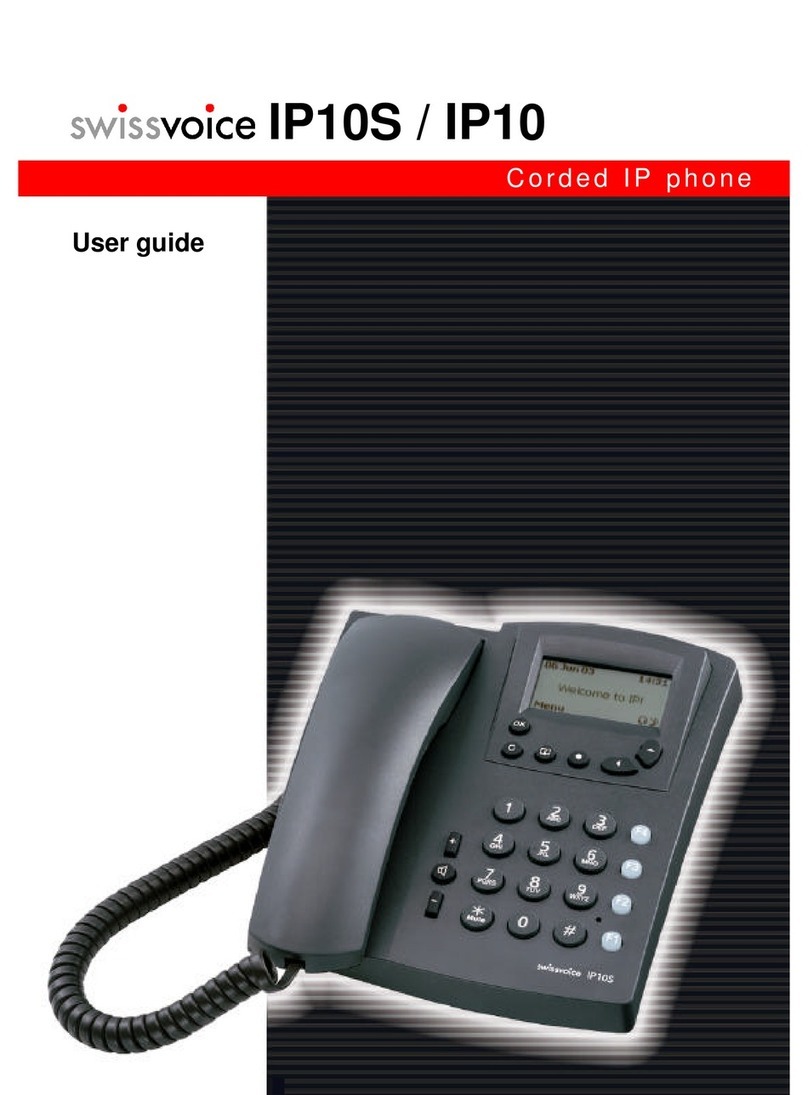
Swissvoice
Swissvoice IP-10 User manual
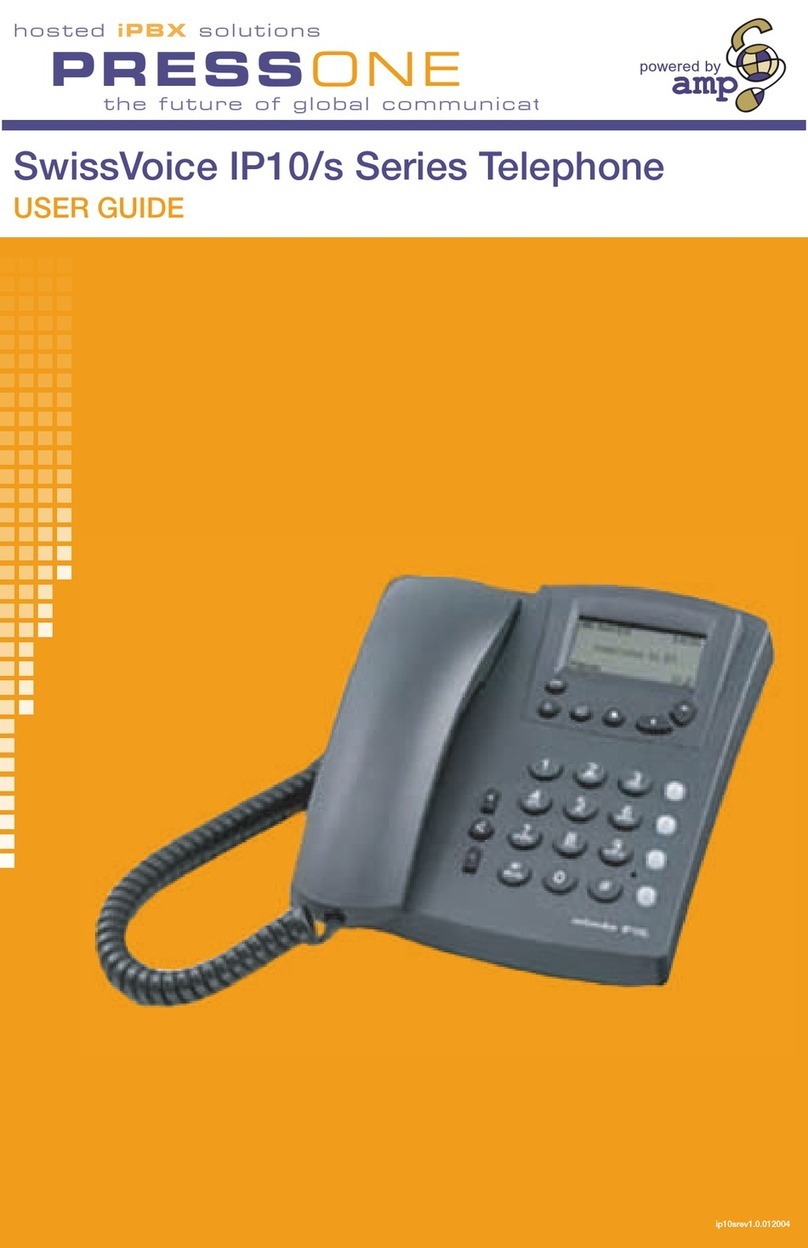
Swissvoice
Swissvoice IP-10 User manual
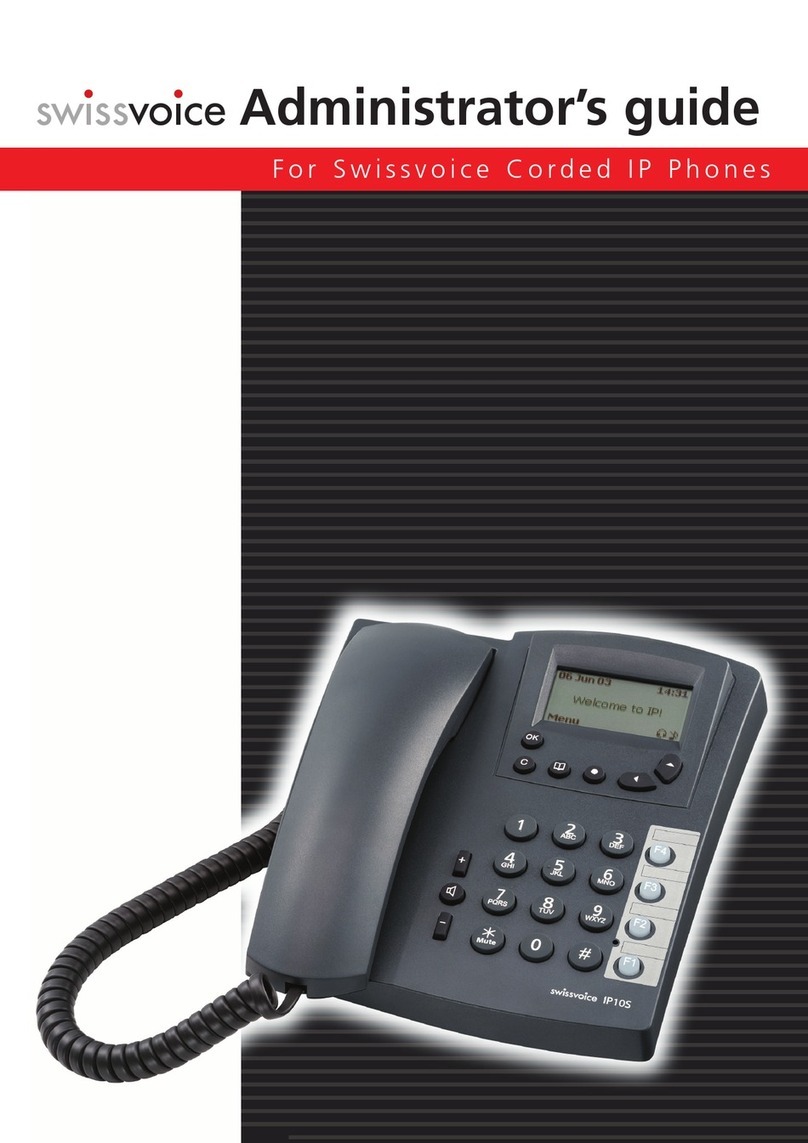
Swissvoice
Swissvoice Corded IP Phones Service manual
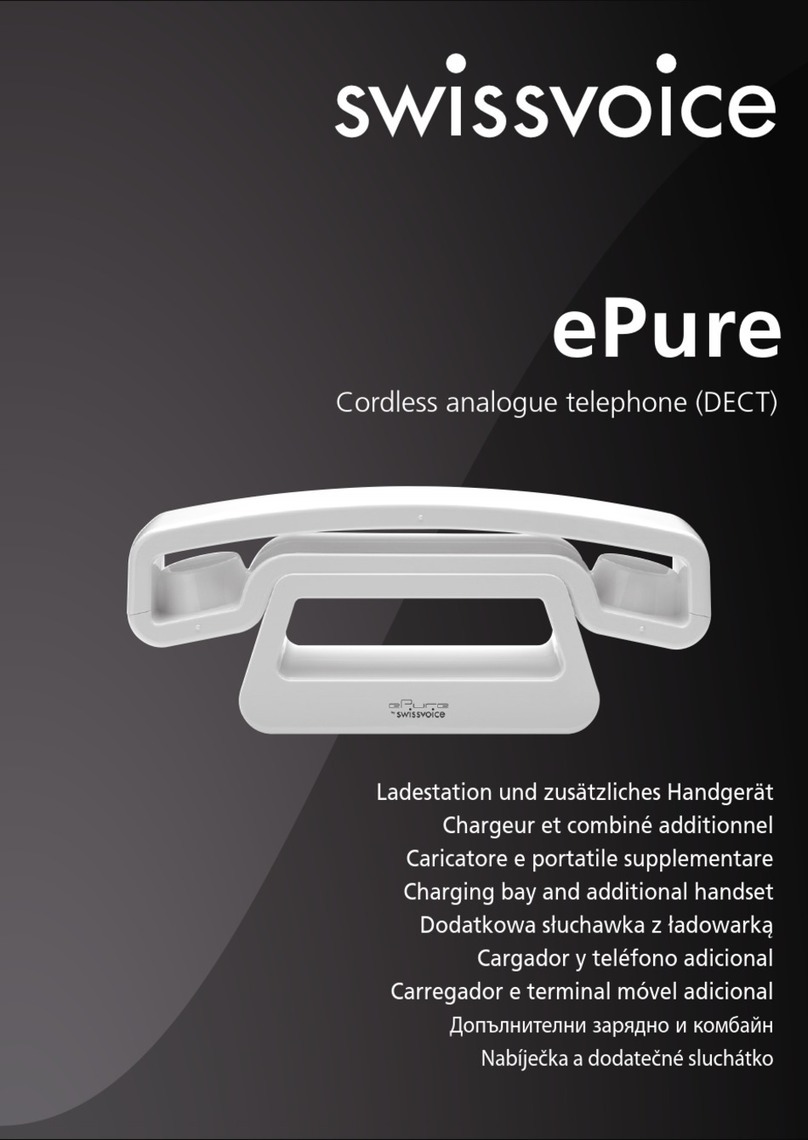
Swissvoice
Swissvoice ePure User manual
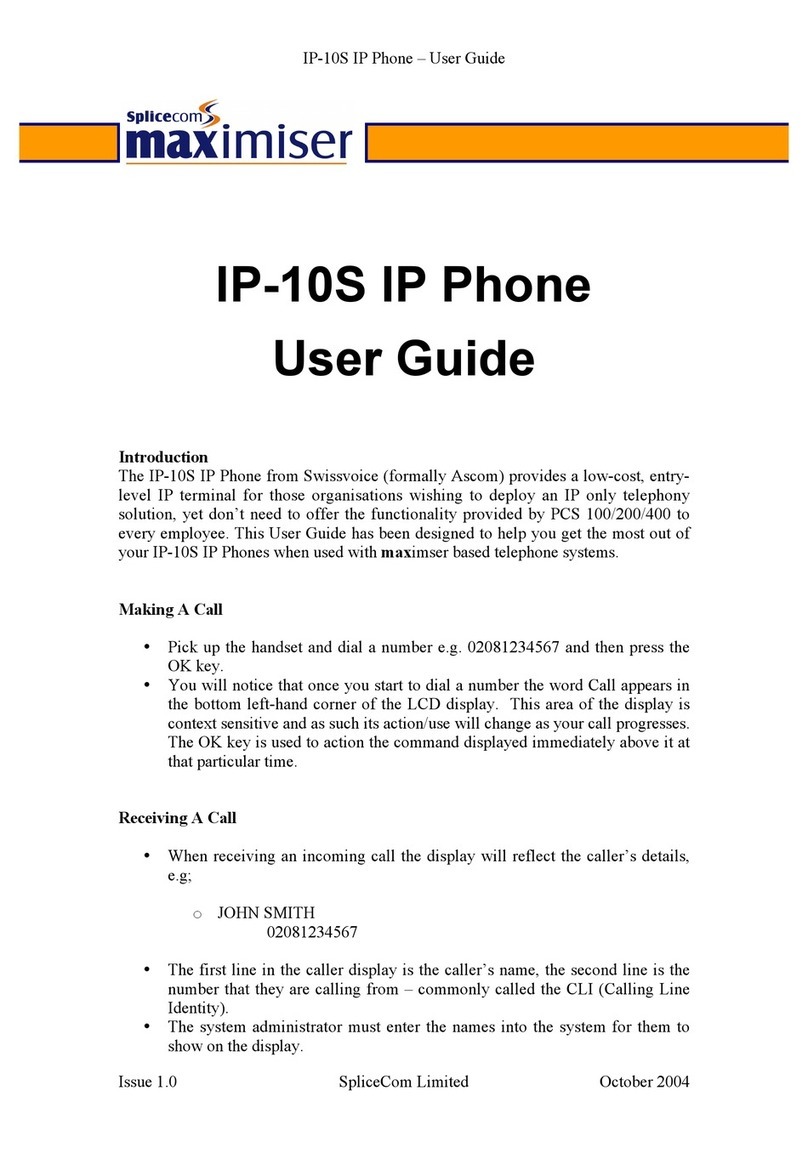
Swissvoice
Swissvoice IP10/S Series User manual
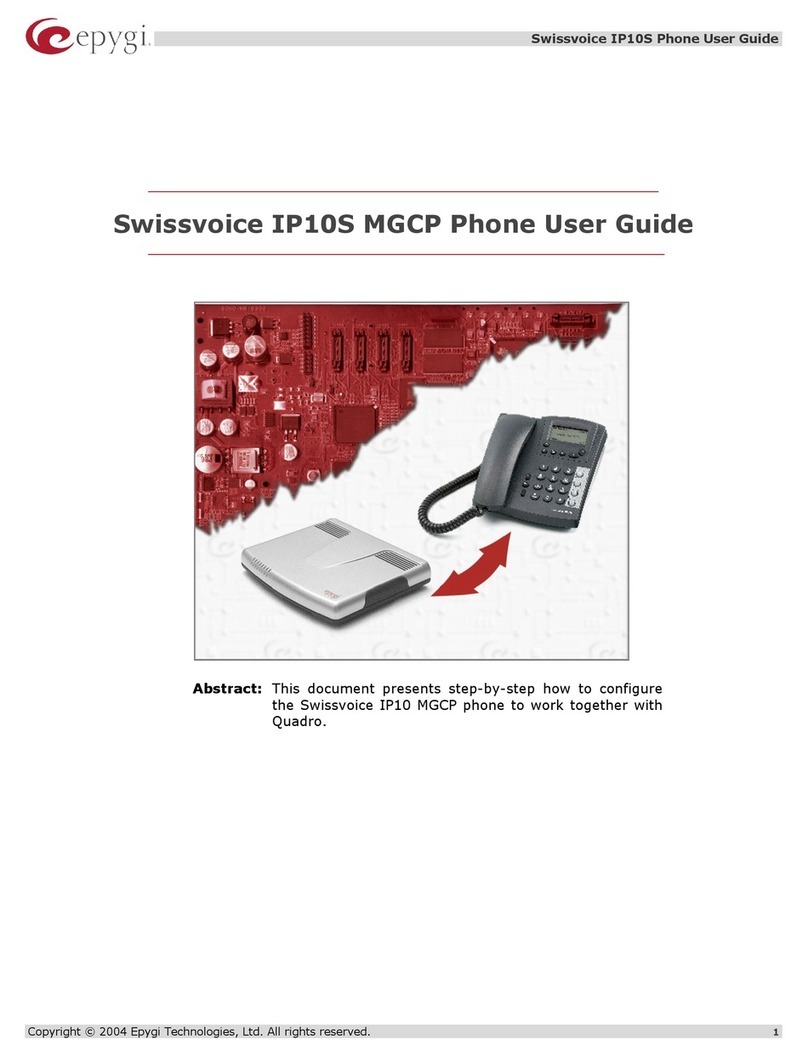
Swissvoice
Swissvoice IP10/S Series User manual

Swissvoice
Swissvoice IP10/S Series User manual

